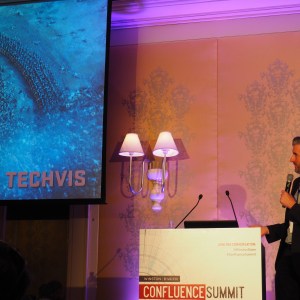The second annual Confluence Summit presented by Winston Baker took place on October 25 in Menlo Park, bringing together professionals from both the tech and entertainment industries. From industry leaders simply attending the conference to those speaking on the panels, the Confluence Summit was another superb expansion on last year’s event, highlighting new developments in virtual reality, new technology and other forms of media.
The first speaker was Ted Schilowitz, a “Futurist” at Paramount Pictures, who spoke about taking risks in storytelling. First noting his eccentric job title, Schilowitz highlighted how his job position empowers him to question business and film studios about how to act more like start-ups — a company structure that allows innovators to strive forward. Schilowitz’s strategy and approach to addressing the audience was just as out-of-the-box as his job title implied, choosing to walk around the room and actively question the audience’s expectations for what a conference looks like. Likewise, he encouraged those in the room who are in the entertainment industry to think beyond traditional structures for business and studios — reaching out to those in the tech industry, too. Because when it comes down to it, Schilowitz asserted, stories and imagination are what bind humans together and set humans apart from other species — so an effective business structure is what should propel a company forward and allow it to be at the forefront of creating stories.
Schilowitz also moderated a panel with several mixed reality and virtual reality (VR) leaders: Hayes Mackaman, the CEO of 8i; Steve Sullivan, the general manager of Mixed Reality Capture Studios at Microsoft; and Tonaci Tran, the CEO of HypeVR. Each company aims to render volumetric video in real-time and deliver to multiple devices, a methodology extraordinarily helpful for new types of special effects. Specifically, the companies focus on human capture in order to cater to the requests of studios — a technique useful for not only film, but gaming and other types of media. Mackaman noted that this type of video capture is something that fascinates people, citing an incident at an 8i event that volumetrically captured a four-second video of attendees, yet attendees spent extraordinary lengths of time captivated by the videos.
Jesse Gold, the President and CEO of Skydance Media, then spoke with Joseph Chianese, the Executive Vice President of Entertainment Partners. Gold noted the collaboration and co-production deal that Skydance currently holds with Paramount through 2021. Skydance has notably produced films including “True Grit,” “Star Trek Beyond,” Annihilation,” and multiple “Mission: Impossible” films. As a company founded in 2010, Skydance is a relatively new company, and its products and market reflect that — Skydance currently has four “pillars”: film, television, Skydance Interactive (games and VR) and Skydance Animation (animated films). In this way, Skydance has a very specific target market and area of content focus — science fiction/action/adventure — that allows the company to hone its brand. Gold emphasized Skydance’s approach to creating content, which is to look at the content and decide what medium is best, rather than the other way around — in this way, a project might stray into either television or film. Gold attributed much of the success of Skydance to this methodology.
After the popularity of “Crazy Rich Asians” this summer — the highest grossing romantic comedy in a decade — Winston Baker presented a conversation between Rebecca Sun, a senior reporter at The Hollywood Reporter, and Adele Lim, one of the co-writers of the screenplay for “Crazy Rich Asians,” directed by Jon M. Chu. Focusing on cross-cultural storytelling, Lim spoke about her avenue in television and film writing as a Malaysian immigrant, stating that she didn’t know that television writing was a career pathway when she was young. After working a number of jobs, she finally decided to pursue television writing. (Lim has written on shows including “One Tree Hill,” “Life Unexpected” and “Star-Crossed.”)
In regards to the massive success of “Crazy Rich Asians,” Lim chose to push the “otherness” that many people of color can relate to — in the film, this manifests itself in the form of Rachel being transplanted to a new place (Singapore) and looking “the same” as other people but ultimately being innately different. Lim sought to avoid stereotypes but understood the opportunity that she had to explore a variety of different character types because the characters in the film aren’t serving as a representative for a race or ethnic group as a whole. Lim emphasized that her goal was not about “paying lip service to diversity” — it wasn’t about writing a person of color into a white character. Rather, she wanted to write an authentic story specifically for these unique characters.
Chris Edwards, founder and CEO of The Third Floor, a visualization and VR company, spoke about the organization’s goal of assisting studios in better representing and understanding their content, making the workflow easier. The company specializes in previsualization (“previs”) as well as postvisualization (“postvis”) — and The Third Floor currently works with and has worked with content including “Game of Thrones,” “Gravity” and “Avatar.” Edwards showed an example of how previs can help directors plan out shots and craft a more effective plan for shooting; in his “Game of Thrones” example, The Third Floor was able to help the director plan a huge battle scene, animating and visualizing camera movement in relation to actors as well as what was shot live and what was added in. Focusing on three different avenues, The Third Floor aims to uplift story development, virtual production and immersive design as its three pillars, streamlining workflow to support creators. Ultimately, Edwards noted, The Third Floor wants to help creators make their content more efficiently. With a company like The Third Floor, creators can better visualize content for not just film, but also gaming, animation, themed attractions, VR, advertising and more.
At lunch, I had the opportunity to speak with Rebecca Sun, and she left me with some words of wisdom. Sun started in sports journalism at Sports Illustrated, graduating from Duke University with a double major in biology and English. After receiving her Master’s in Journalism from NYU, Sun moved to Sports Illustrated — she jokingly mentioned that she had virtually no sports background at all. I was fascinated by her move from Sports Illustrated to The Hollywood Reporter, where she specializes in reporting on representation and stories from artists of color in media. Why, I asked, did you start at Sports Illustrated? Sun quoted her editor at this point, stating that she felt a sense of disillusionment at Sports Illustrated and not knowing anything about sports like her peers. Yet her editor told her that as a talented journalist, it was less about the sports and ultimately more about her ability to craft a compelling narrative even in a journalistic article.
Like Schilowitz said, it’s all about the story.
Contact Olivia Popp at oliviapopp ‘at’ stanford.edu.





